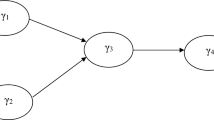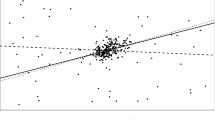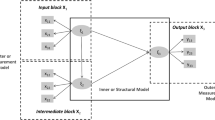Abstract
Since its inception, partial least squares path modeling has suffered from the absence of a single optimization criterion for estimating component weights. A new estimation procedure is proposed to address this enduring issue The proposed procedure aims to minimize a single least squares criterion for estimating component weights under both Mode A and Mode B. An alternating least squares algorithm is developed to minimize the criterion. This procedure provides quite similar or identical solutions to those obtained from existing Lohmöller’s algorithm in real and simulated data analyses. The proposed procedure can serve as an alternative to the existing one in that it is well-grounded in theory as well as performs comparably in practice.
Similar content being viewed by others
References
Addinsoft (2009). XLSTAT 2009. Ftemoec Addinsoft.
Chin, W. W. (2001).PLS-Graph user’s guide version 3.0. Soft Modeling Inc.
Coolen, H., & de Leeuw, J. (1987). Least squares path analysis with optimal scaling. Paper presented at the fifth international symposium of data analysis and informatics. Versailles, France
de Leeuw, J., Young, F. W., & Takane, Y. (1976). Additive structure in qualitative data: An alternating least squares method with optimal scaling features. Psychometrika, 41, 471–503.
Dijkstra, T. K. (2010). Latent variables and indices: Herman Wold’s basic design and partial least squares. In V. Esposito Vinzi, W. W. Chin, J. Henseler, & H. Wang (Eds.), Handbook of Partial Least Squares: Concepts, Methods and Applications (pp. 23–46).Berlin: Springer-Verlag.
Esposito Vinzi, V., Trinchera, L., & Amato, S. (2010). PLS path modeling: from foundations to recent developments and open issues for model assessment and improvement. In V. Esposito Vinzi, W. W. Chin, J. Henseler, & H. Wang (eds.), Handbook of partial least squares. Concepts, methods, and applications (pp. 47–82). Berlin: Springer-Verlag.
Fornell, C., Johnson, M. D., Anderson, E. W., Cha, J., & Bryant, B. E. (1996). The American customer satisfaction index: Nature, purpose, and findings. Journal of Marketing, 60, 7–18.
Gifi, A. (1990). Nonlinear multivariate analysis. Chichester: Wiley.
Hanafi, M. (2007). PLS path modeling: computation of latent variables with the estimation mode B. Computational Statistics, 22, 275–292.
Henseler, J. (2010). On the convergence of the partial least squares path modeling algorithm. Computational Statistics, 25, 107–120.
Jöreskog, K. G. (1970). A general method for analysis of covariance structures. Biometrika, 57, 409–426.
Jöreskog, K. G. & Wold, H. (1982). The ML and PLS techniques for modeling with latent variables: Historical and comparative Aspects. In H. Wold & K. G. Jöreskog (eds.), Systems under Indirect observation: causality, structure, prediction, part I (pp. 263–270). Amsterdam: North-Holland.
Lohmöller, J.-B. (1984). LVPLS program manual Cologne, Germany: Zentralarchiv für Empirische Sozialforschung, Universitätzu Köln.
Lohmöller, J.-B. (1989). Latent variable path modeling with partial least squares. New York: Springer-Verlag.
McDonald, R. P. (1996). Path analysis with composite variables. Multivariate Behavioral Research, 31, 239–270.
Ringle, C. M., Götz, O., Wetzels, M., & Wilson, B. (2009). On the use of formative measurement specifications in structural equation modeling: A Monte Carlo simulation study to compare oovarianoe-based and partial least squares model estimation methodologies. Munich Personal RePEc Archive Paper No. 15390. Available online at http://mpra.ub.unimuenchen.de/15390/.
Ringle, C. M., Wende, S., & Will, A. (2005). SmartPLS 2.0 (beta). Hamburg: Germany.
Tenenhaus, A., & Tenenhaus, M. (2011). Regularized generalized canonical correlation analysia. Paychometrika, 76, 257–284.
Tenenhaus, M. (2008). Components based structural equation modelling. Total Quality Management and Business Excellence, 19, 871–886.
Tenenhaus, M., Esposito Vinzi, V., Chateline, Y.-M., & Lauro, C. (2005). PLS Path Modeling. Computational Statistics and Data Analysis, 48, 159–205.
Wold, H. (1966). Estimation of principal components and related methods by iterative least squares. In P. R. Krishnaiah (ed.), Multivariate analysis (pp. 391–420). New York: Academic Press.
Wold, H. (1973). Nonlinear iterative partial least squares (NIPALS) modeling: Some current developments. In P. R. Krishnaiah (ed.), Multivariate analysis (pp. 383–487). New York: Academic Press.
Wold, H. (1982). Soft modeling: The basic design and some extensions. In K. G. Jöreskog & H. Wold (eds.), Systems under indirect observations II (pp. 1–54). Amsterdam: North-Holland.
Young, F. W. (1981). Quantitative analysis of qualitative data. Psychometnka, 46, 357–388.
Author information
Authors and Affiliations
Corresponding author
About this article
Cite this article
Hwang, H., Takane, Y. & Tenenhaus, A. An Alternative Estimation Procedure for Partial Least Squares Path Modeling. Behaviormetrika 42, 63–78 (2015). https://doi.org/10.2333/bhmk.42.63
Received:
Revised:
Published:
Issue Date:
DOI: https://doi.org/10.2333/bhmk.42.63




